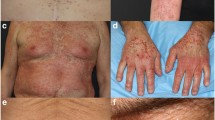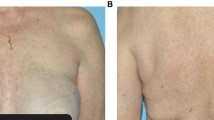Abstract
Purpose Dermatologic events (DEs) in patients with cancer treated with lapatinib, a small-molecule dual tyrosine kinase inhibitor (TKI) of epidermal growth factor receptor (EGFR [ErbB1]) and HER2 (ErbB2), were characterized. Patients and methods Nine clinical trials of metastatic cancer were included in this analysis. Lapatinib was administered at doses ranging from 1000 to 1500 mg/day as monotherapy (n = 928) or in combination with paclitaxel or capecitabine (n = 491). Patients not treated with lapatinib comprised the control group. Dermatologic events included hand-foot syndrome, rash, hair disorder, dry skin, pruritus/urticaria, skin disorder, skin infection, and nail disorder; DEs were characterized based on type, time to onset, severity, duration, and required interventions. Results Fifty-eight percent of patients treated with lapatinib monotherapy, 74% treated with lapatinib plus paclitaxel or capecitabine, and 53% in the control group developed DEs. Among patients receiving lapatinib monotherapy, 55% experienced grade 1/2 DEs, 3% had grade 3 DEs, and no grade 4 DEs were observed. The most common DE was rash (43%); all other events occurred in ≤8% of patients. Most DEs developed between days 1 and 14 of starting treatment, with a median duration of 29 days. Three percent of DEs led to lapatinib dose reduction, 7% resulted in dose interruption, and 1% led to drug discontinuation. Conclusions Most DEs in lapatinib-treated patients present early, are mild to moderate in severity, and infrequently require dose modification or treatment interruption. Lapatinib-associated DEs appear to differ clinically from those associated with EGFR TKIs in both frequency and severity.



Similar content being viewed by others
References
Dei Tos AP, Ellis I (2005) Assessing epidermal growth factor receptor expression in tumours: what is the value of current test methods? Eur J Cancer 41:1383–1392
Itakura Y, Sasano H, Shiga C et al (1994) Epidermal growth factor receptor overexpression in esophageal carcinoma. An immunohistochemical study correlated with clinicopathologic findings and DNA amplification. Cancer 74:795–804
Agero AL, Dusza SW, Benvenuto-Andrade C et al (2006) Dermatologic side effects associated with the epidermal growth factor receptor inhibitors. J Am Acad Dermatol 55:657–670
Lacouture ME (2006) Mechanisms of cutaneous toxicities to EGFR inhibitors. Nat Rev Cancer 6:803–812
Galimont-Collen AF, Vos LE, Lavrijsen AP et al (2007) Classification and management of skin, hair, nail and mucosal side-effects of epidermal growth factor receptor (EGFR) inhibitors. Eur J Cancer 43:845–851
Perez-Soler R, Saltz L (2005) Cutaneous adverse effects with HER1/EGFR-targeted agents: is there a silver lining? J Clin Oncol 23:5235–5246
Wagner LI, Lacouture ME (2007) Dermatologic toxicities associated with EGFR inhibitors: the clinical psychologist’s perspective. Oncology 21(11 suppl 5):34–36
Tykerb [package insert] (2007) GlaxoSmithKline, Research Triangle Park, NC
Fields AL, Rinaldi DA, Henderson CA et al (2005) An open-label multicenter phase II study of oral lapatinib (GW572016) as single agent, second-line therapy in patients with metastatic colorectal cancer [abstract]. J Clin Oncol 23(suppl):266s. Abstract 3583
Ross HJ, Blumenschein GR, Dowlati A et al (2005) Preliminary safety results of a phase II trial comparing two schedules of lapatinib (GW572016) as first line therapy for advanced or metastatic non-small cell lung cancer [abstract]. J Clin Oncol 23(suppl):645s. Abstract 7099
Wulfing C, Machiels J, Richel D et al (2005) A single arm, multicenter, open-label, phase II study of lapatinib as 2L treatment of patients with locally advanced/metastatic transitional cell carcinoma (TCC) of the urothelial tract [abstract]. J Clin Oncol 23(suppl):401s. Abstract 4594
Ravaud A, Gardner J, Hawkins R et al (2006) Efficacy of lapatinib in patients with high tumor EGFR expression: results of a phase III trial in advanced renal cell carcinoma (RCC). J Clin Oncol 24(suppl):217s. Abstract 4502
Geyer CE, Forster J, Lindquist D et al (2006) Lapatinib plus capecitabine for HER2-positive advanced breast cancer. N Engl J Med 355:2733–2743
Dhillon S, Wagstaff AJ (2007) Lapatinib. Drugs 67:2101–2108; discussion 2109–2110
Mukherjee A, Dhadda AS, Shehata M et al (2007) Lapatinib: a tyrosine kinase inhibitor with a clinical role in breast cancer. Expert Opin Pharmacother 8:2189–2204
Montemurro F, Valabrega G, Aglietta M (2007) Lapatinib: a dual inhibitor of EGFR and HER2 tyrosine kinase activity. Expert Opin Biol Ther 7:257–268
Burris HA, Hurwitz HI, Dees EC et al (2005) Phase I safety, pharmacokinetics, and clinical activity study of lapatinib (GW572016), a reversible dual inhibitor of epidermal growth factor receptor tyrosine kinases, in heavily pretreated patients with metastatic carcinomas. J Clin Oncol 23:5305–5313
Cancer Therapy Evaluation Program (1999) Common toxicity criteria, version 2.0. http://ctep.cancer.gov/forms/CTCv20_4-30-992.pdf. Accessed 7 Feb 2008
Cancer Therapy Evaluation Program (2006) Common terminology criteria for adverse events, version 3.0 (CTCAE). http://ctep.cancer.gov/forms/CTCAEv3.pdf. Accessed 7 Feb 2008
Hsieh S, Tobien T, Koch K et al (2004) Increasing throughput of parallel on-line extraction liquid chromatography/electrospray ionization tandem mass spectrometry system for GLP quantitative bioanalysis in drug development. Rapid Commun Mass Spectrom 18:285–292
Tarceva [package insert] (2007) OSI Pharmaceuticals Inc, Melville, NY
Nexavar [package insert] (2007) Bayer Pharmaceuticals Corp, West Haven, CT
Lynch TJ Jr, Kim ES, Eaby B et al (2007) Epidermal growth factor receptor inhibitor-associated cutaneous toxicities: an evolving paradigm in clinical management. Oncologist 12:610–621
Wood ER, Truesdale AT, McDonald OB et al (2004) A unique structure for epidermal growth factor receptor bound to GW572016 (Lapatinib): relationships among protein conformation, inhibitor off-rate, and receptor activity in tumor cells. Cancer Res 64:6652–6659
Amador ML, Oppenheimer D, Perea S et al (2004) An epidermal growth factor receptor intron 1 polymorphism mediates response to epidermal growth factor receptor inhibitors. Cancer Res 64:9139–9143
Nanney LB, Stoscheck CM, King LE Jr et al (1990) Immunolocalization of epidermal growth factor receptors in normal developing human skin. J Invest Dermatol 94:742–748
Kari C, Chan TO, Rocha de Quadros M et al (2003) Targeting the epidermal growth factor receptor in cancer: apoptosis takes center stage. Cancer Res 63:1–5
Lacouture ME, Lai SE (2006) The PRIDE (Papulopustules and/or paronychia, Regulatory abnormalities of hair growth, Itching, and Dryness due to Epidermal growth factor receptor inhibitors) syndrome. Br J Dermatol 155:852–854
Erbitux [package insert] (2007) Imclone Systems Inc, Branchburg, NJ
Vectibix [package insert] (2007) Amgen Inc, Thousand Oaks, CA
Iressa [package insert] (2005) AstraZeneca Pharmaceuticals, Wilmington, DE
Jacot W, Bessis D, Jorda E et al (2004) Acneiform eruption induced by epidermal growth factor receptor inhibitors in patients with solid tumours. Br J Dermatol 151:238–241
Xeloda [package insert] (2006) Roche Pharmaceuticals, Nutley, NJ
Jatoi A, Rowland K, Sloan JA et al (2007) Does tetracycline prevent/palliate epidermal growth factor receptor (EGFR) inhibitor-induced rash? A phase III trial from the North Central Cancer Treatment Group (N03CB) [abstract]. J Clin Oncol 25(suppl):494s. Abstract LBA9006
Lacouture ME, Cotliar J, Mitchell EP (2007) Clinical management of EGFRI dermatologic toxicities: US perspective. Oncology (Williston Park) 21:17–21
Acknowledgments
We would like to thank the patients who enrolled in these studies, the medical personnel who cared for them, and Shradha Sainju from GlaxoSmithKline. We would also like to thank Jeff Riegel, PhD, and Ann Marie Fitzmaurice, PhD, ProEd Communications, Inc.® for their medical editorial assistance. Dr. Lacouture is supported by a Zell Scholarship from the Robert H Lurie Comprehensive Cancer Center of Northwestern University. GlaxoSmithKline conducted the clinical studies (i.e., funded, designed, and analyzed data) that were included in the pooled analysis of skin events associated with lapatinib treatment. GlaxoSmithKline also provided statistical support for the pooled analysis and medical writing support for manuscript development. M.E. Lacouture and M. Koehler were involved in the conception of the manuscript. A.J. Preston, M. Koehler, M.E. Lacouture, R. Sweetman, and K.L. Blackwell contributed to the design of the analysis. S.M. Laabs, V.M. Salazar, M. Koehler, R.W. Sweetman, A. Di Leo, and H.L. Gomez were involved in patient recruitment. M.E. Lacouture, S.M. Laabs, M. Koehler, R.W. Sweetman, A. Di Leo, V.M. Salazar, and K.M. Koch were involved in the collection and assembly of data and in data analysis and interpretation. As safety manager for lapatinib, J.A. Byrne contributed data and interpretation of side effects. M.E. Lacouture, S.M. Laabs, M. Koehler, V.M. Salazar, K.M. Koch, K.L. Blackwell, and J.A. Byrne contributed to manuscript development. All authors reviewed, revised, and approved the final draft of the manuscript.
Author information
Authors and Affiliations
Corresponding author
Rights and permissions
About this article
Cite this article
Lacouture, M.E., Laabs, S.M., Koehler, M. et al. Analysis of dermatologic events in patients with cancer treated with lapatinib. Breast Cancer Res Treat 114, 485–493 (2009). https://doi.org/10.1007/s10549-008-0020-7
Received:
Accepted:
Published:
Issue Date:
DOI: https://doi.org/10.1007/s10549-008-0020-7




